The language of flowers is beauty, so it is not surprising that they are often one of the first considerations for landscape ornamentation.
Flowers come in various colors, including yellow, red, pink, blue, white, and much more.
Yellow flowers are pretty unique because they represent different concepts. For one, in places like Japan, yellow flowers are considered sacred and regal.
Generally, yellow flowers signify friendship, joy, truth, appreciation, and hope. But to a French person, it may also denote jealousy – yellow is thought to be a color of jealousy to the French.
Besides being symbolic in various ways, yellow flowers effortlessly raise the appeal of gardens with their bright, soft, popping tone.
In this article, we compile a list of various types of yellow flowers. So, if you ever decide to beautify your garden or give some flowers to a person, you can choose from this list.
Table of Contents
Begonia

Begonia flowers come in various colors, including yellow, orange, white, red, and pink. They are available in different varieties, most of which have double blooms.
Begonia flowers bloom atop dark green leaves. In different places, it is considered a flowering shrub.
Begonia flowers thrive in moist, well-drained soil. They are best grown in full sun or partial shade. But ensure they are not exposed to intense sunlight and strong winds.
Begonias do not do well in hot climates, and they may break when exposed to strong winds. So, if you want to grow some in your garden, take note of these tips.
Yellow Begonia flowers are symbolic of joy, contentment, and wealth. They are best grown in zones 6 to 11.
Black-Eyed Susan

While Black-Eyed Susan flowers look like daisies, they are not daisies. In fact, they are typically taller than daisies, reaching heights of up to 4 feet.
Black-Eyed Susan flowers are sturdy, annual plants. They have yellow to golden pseudanthium (flower heads) and dark brown to black centers. Hence, the “Black Eye” in Black-Eyed Susan.
You could mix Black-Eyed Susans with shrubs and annuals in your garden; their bright yellow color harmonizes pretty well. Also, with shrubs around, tall Black-Eyed Susans can find some support.
Black-Eyed Susans symbolize hope. So, you could offer them to someone going through a tough time. Black-Eyed Susans also stand for equality and fairness.
Black-Eyed Susans are best grown in zones 3 to 11. They thrive in moist, well-drained soil and need full sun or partial shade.
Bulbine
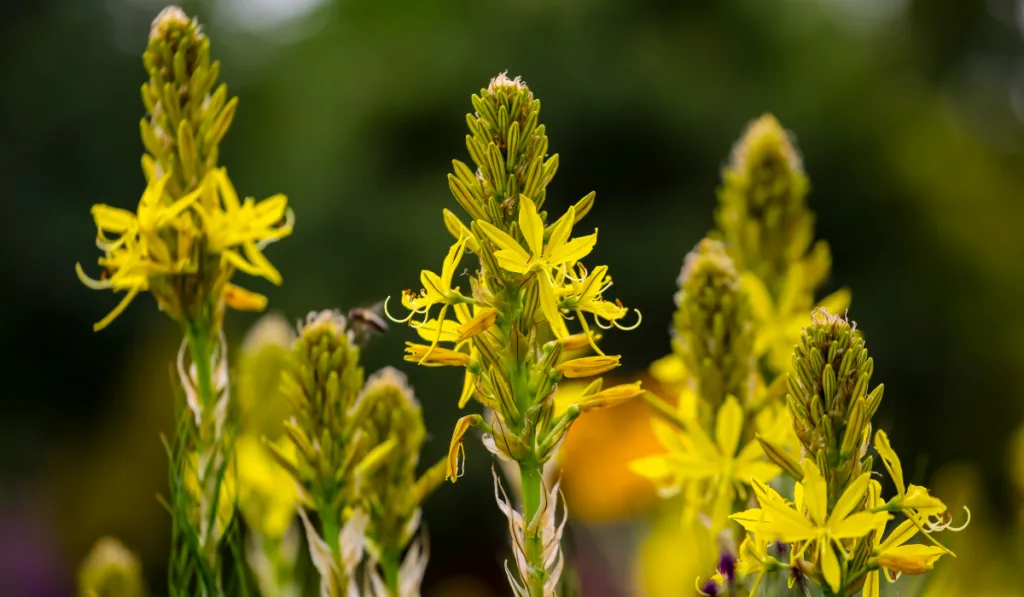
Bulbines are perennial succulents. They come with yellow or orange flowers and foliage that looks like grass.
If you want to grow Bulbines, you need well-drained soil, which must be watered regularly. You must also expose the plant to full sun.
Bulbine stalks typically grow as tall as 2 feet. They grow in clumps, so as some flowers die, remove them so new blooms can appear.
Bulbines originated from South Africa, so it is no surprise they thrive in heat and dry soil. They do best in growing zones 9 to 11, and if you live in Florida, growing them should be easier for you.
Calla Lily

Calla Lilies produce stylish bell-shaped flowers. They are trendy as cut flowers and in gardens, thanks to their unusual form.
Calla Lilies can be grown indoors and outdoors. Ideal growing conditions should include moist, well-drained soil and full sun or partial shade.
When planting Calla Lilies, ensure you sow them deep in the soil. Calla Lilies should be watered routinely. If you intend to plant them outdoors, wait till after the last frost date.
Calla Lilies are best grown in zones 8 to 10. They signify change, growth, and joy.
Coreopsis
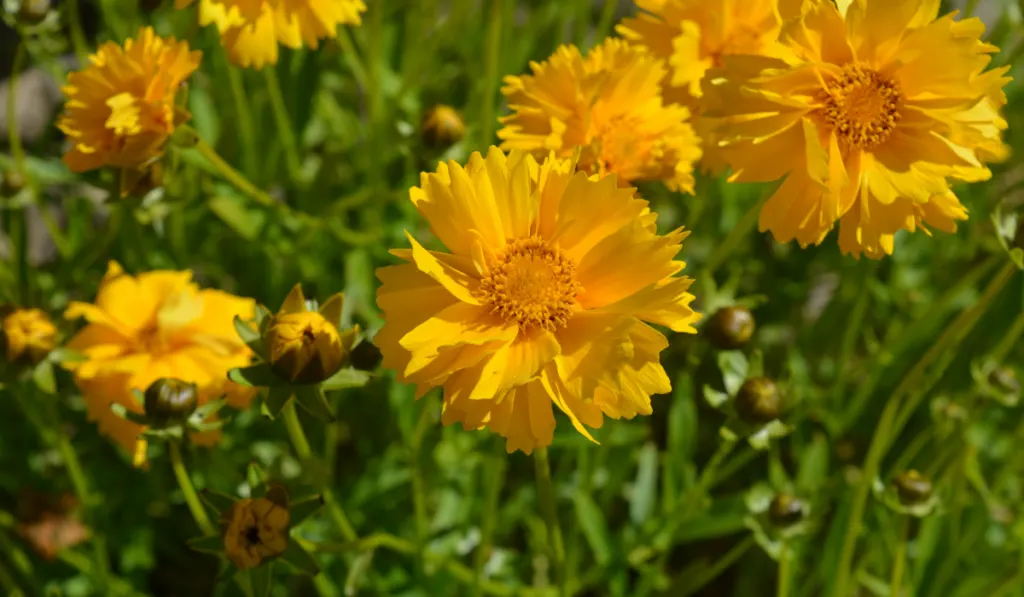
Coreopsis is a low-maintenance perennial plant perfect for beginner gardeners. It may also be called Pot of Gold or Tickseed.
Coreopsis flowers are yellow, and they grow like daisies. Besides yellow, the blooms may also come with pink petals. For optimal growth, Coreopsis flowers need well-drained soil and exposure to full sun. They should also be watered regularly and extensively.
Coreopsis flowers can be one of the most long-lasting blooms in your garden if you remove dead heads routinely.
Coreopsis flowers thrive best in zones 3 to 9.
Craspedia

Craspedia flowers come shaped like tennis balls. Sometimes, they even grow as big as tennis balls.
Craspedia flowers should be grown in well-drained soil and exposed to full sun for optimal growth. However, they can manage on partial shade.
Craspedia flowers are low-maintenance; they are resistant to most pests and diseases. They also do well in various soil types, and they typically do not need regular watering. So, if you are a beginner, this is one option to try out.
Craspedia flowers are more common in the warmer regions of the world. They are best grown in growing zones 8 to 11.
Daffodil

Daffodil flowers have a star-shaped background and a trumpet-shaped foreground, and it is not rare for these two parts to come in different colors. Daffodil flowers are commonly white, but yellow blooms are also popular.
They are best grown in well-drained soil while exposed to full sun. When planting Daffodils, ensure you plant them at a depth that is three times their bulb height. If you do not plant them as such, they will bend when they start blooming.
Daffodil flowers represent friendship, healing, and hope. They grow best in zones 3 to 10.
Gerbera Daisy
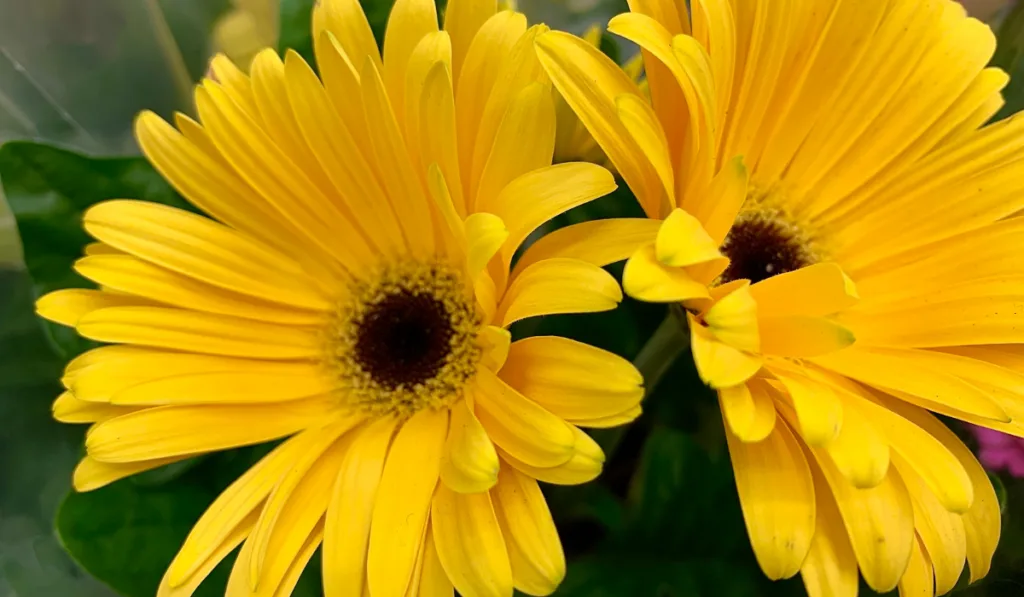
As the name says, Gerbera Daisies are daisies. They are one of the most widely used flowers in the world, and you may have come across them at events where flowers were used as design.
The flowers of Gerbera Daisies come in different colors. And like every other color of Gerbera Daisies, the yellow blooms are bright and pleasant.
Gerbera Daisies should be grown in well-drained soil while exposed to full sun. Avoid planting them too deeply, or they may suffer crown rot.
Gerbera Daisies are best grown in zones 9 to 11. Their flowers represent cheerfulness.
Goldenrod
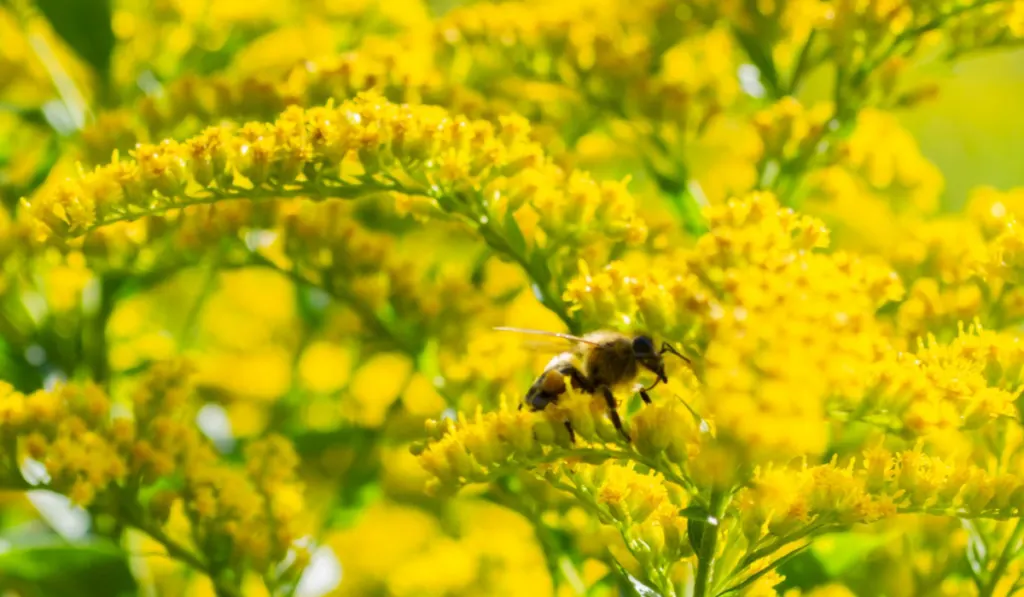
Goldenrods are perennial wildflowers. They come as tall leafy stalks with small-sized flower clusters around their ends.
Goldenrod flowers have a deep-yellow to golden color, hence their name. They are late bloomers, so you may have to wait till late summer or early fall for them to flower.
If you do not have expansive space in your garden, opt for shorter Goldenrod varieties. Goldenrods typically grow and spread out of control. So, with insufficient space, they can be less appealing.
Be cautious when gifting Goldenrod flowers. They are said to contain high levels of pollen, so they may trigger allergies.
Goldenrods thrive in well-drained soil and full sun or partial shade. They grow best in zones 4 to 9.
Hellebores
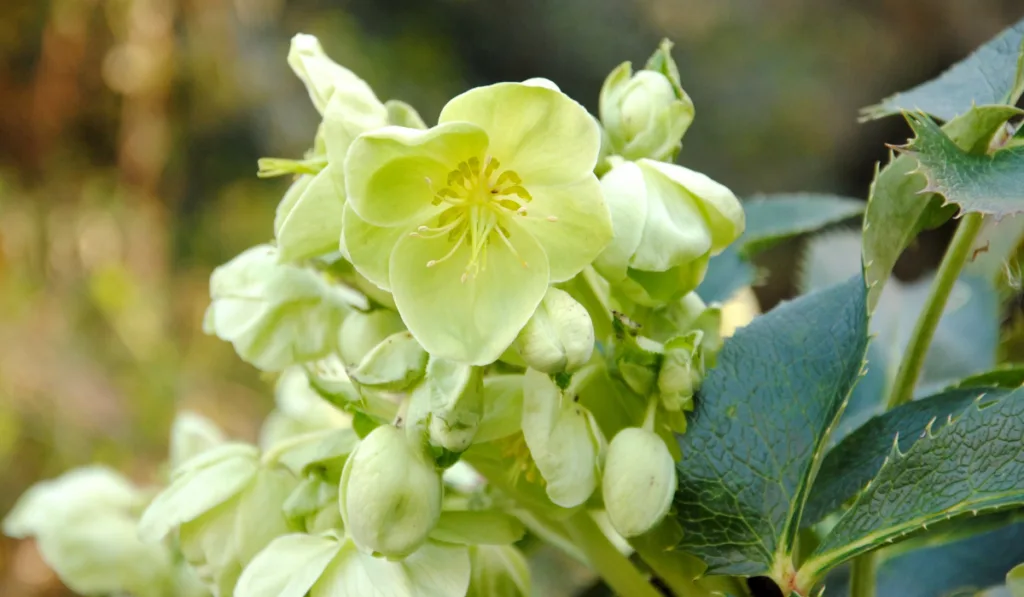
Hellebores are perennials known for their extended blooming period. Under appropriate conditions, they can keep blooming for around 6 to 8 weeks.
Hellebores plants come with leathery leaves, which encircle the tiny petals at the center. Their flowers come in various colors, including yellow, purple, and white.
Hellebores need full sun for optimal growth. But they can also survive with partial shade. Hellebores should be planted in well-drained soil, and they should not be sown too deeply.
Hellebores are best grown in zones 4 to 8. Their flowers are said to symbolize peace and the wish of a beautiful year ahead.
Hibiscus

The trumpet-shaped flowers of the hibiscus plant grow on small trees, and they come in various colors, including yellow, orange, pink, red, and multicolor. Hibiscus flowers grow alongside dark green leaves.
Hibiscus plants thrive best in moist, well-drained soil and full sun or partial shade. They are sensitive to cold, so ensure they are not exposed to freezing temperatures. Hibiscus plants are also easily affected by drought, so keep them moist.
Generally, Hibiscus plants are easy to maintain. They grow pretty fast and can spread at the same pace if not controlled.
Hibiscus flowers are best raised in zones 5 to 8. Their flowers denote happiness, summer, and positivity.
Iris
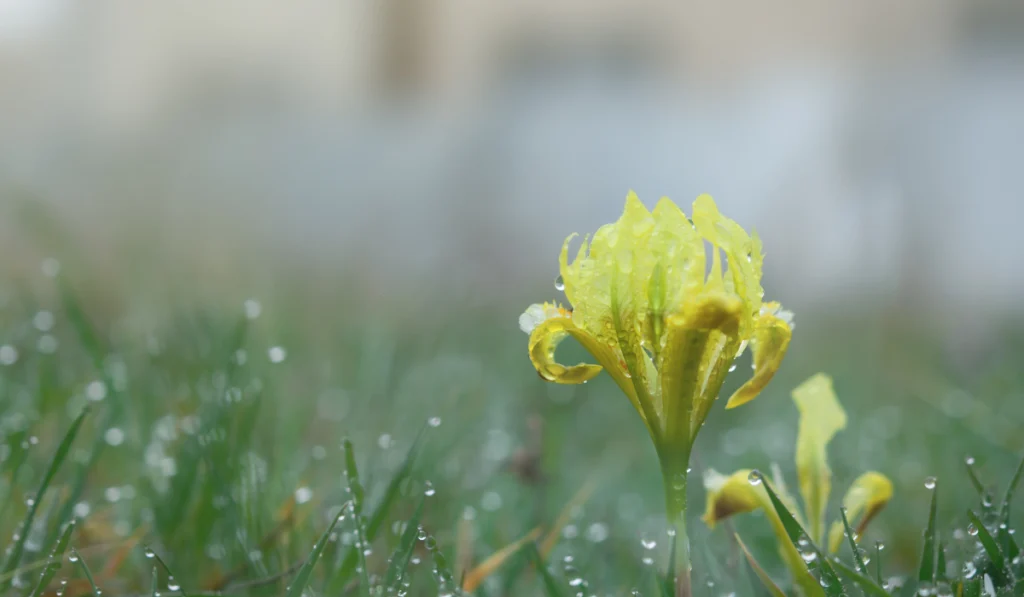
Iris flowers come in various colors, including yellow, blue, pink, purple, orange, and white. They come as 3 erect petals alongside 3 drooping petals. It is not unusual for both sets of petals to have different colors.
Iris plants grow best in well-drained soil. But while some varieties prefer acidic soil, others need alkaline soil. Iris should be watered regularly and thoroughly for the best outcomes.
Iris plants grow best in full sun, but they can also thrive in partial shade. Their flowers are exceptional because they bloom twice: early spring and late summer.
Iris plants grow best in zones 3 to 9. Their flowers represent purity, hope, and wisdom.
Marigold
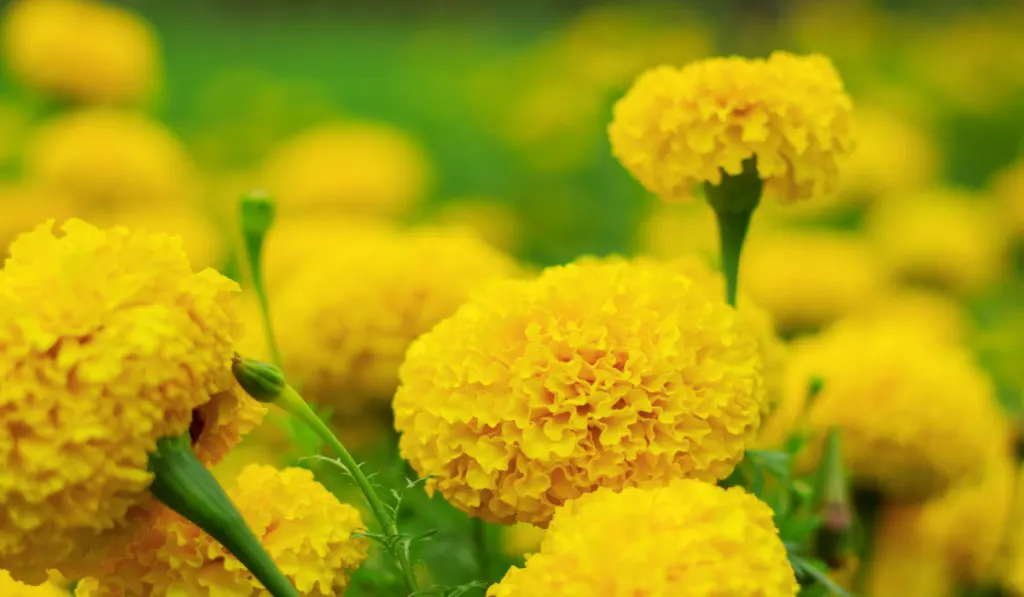
Marigolds are annuals well-known for their intense scent, bright colors, and ability to bloom all through summer.
Marigold flowers have bulbous heads shaped like those of Carnation flowers. Plus, their petals cluster to form a thick, ruffled layer.
Marigolds will grow in any type of soil as long as it is well-drained. However, they thrive best in full sun – they need lots of it. When watering Marigold plants, go for the base, not the head. Also, ensure you only water the plant when the soil is dry again.
If you have a pest problem in your garden, Marigold plants can serve as biological pest control. Their intense smell is known to drive off some pests. Marigold plants thrive in zones 9 to 11.
In general, their flowers represent happiness. However, in Mexico, it is a symbol of death.
Pansy

Pansies are a type of viola flower. They are annuals revered for their hardiness, and they can be used as ground covers and border plants.
Pansy flowers come in various colors, including yellow. Their flowers, while tiny, require a lot of moisture to grow properly.
Pansy flowers grow best in moist, well-drained soil. Like most viola flowers, they need full sun for optimal growth.
You can get pansy flowers at various times throughout the year as the plant blossoms in any season.
Pansies are best grown in zone 4 to 8. Generally, their flowers symbolize loving feelings and admiration for a person. However, yellow pansy flowers represent positivity, joy, and happiness.
Primrose

Primrose blooms into fragrant, goblet-shaped flowers of various colors. Primrose flowers can be yellow, white, or pink.
Evening primrose flowers are low-maintenance. In fact, they can survive by the roadside with no care at all. Primroses grow pretty quickly, so ensure you pay attention to them and control them. The plants can grow as tall as 2 feet.
For optimal growth, primroses need well-drained soil and full sun. They grow best in zones 3 to 11. Primrose flowers symbolize patience, optimism, youth, and kindness.
Roses
It turns out roses are not always red! Roses come in more than 2000 varieties, and each one can come in a broad array of colors. Of course, one of the many colors is yellow.
If you desire fragrance and disease resistance, opt for old roses. But if you want all-season blooms and more colors to choose from, go for modern roses.
Yellow roses are typically gifted to bring happiness to the receiver. They represent friendship and are attributed to the warmth of a sunny day.
Roses grow best in moist, well-drained soil. They need at least 5-6 hours of full sun daily to thrive, and they grow best in zones 3 to 11.
Snapdragon

Snapdragons come in many colors, excluding blue. They are medium-sized perennial plants with an unusual growth pattern: their stalks grow first, then the blooms appear.
Snapdragons are typically mixed with tall, background plants or short, bedding plants to create a balance. They grow best in full sun and well-drained soil. As the plant grows, clip the long side shoots and top stem to promote growth.
Yellow Snapdragon flowers represent good luck, positive energy, and happiness.
You can plant Snapdragons early in the season because they are a bit tolerant to frost. They thrive best in zones 7 to 10.
Sunflower
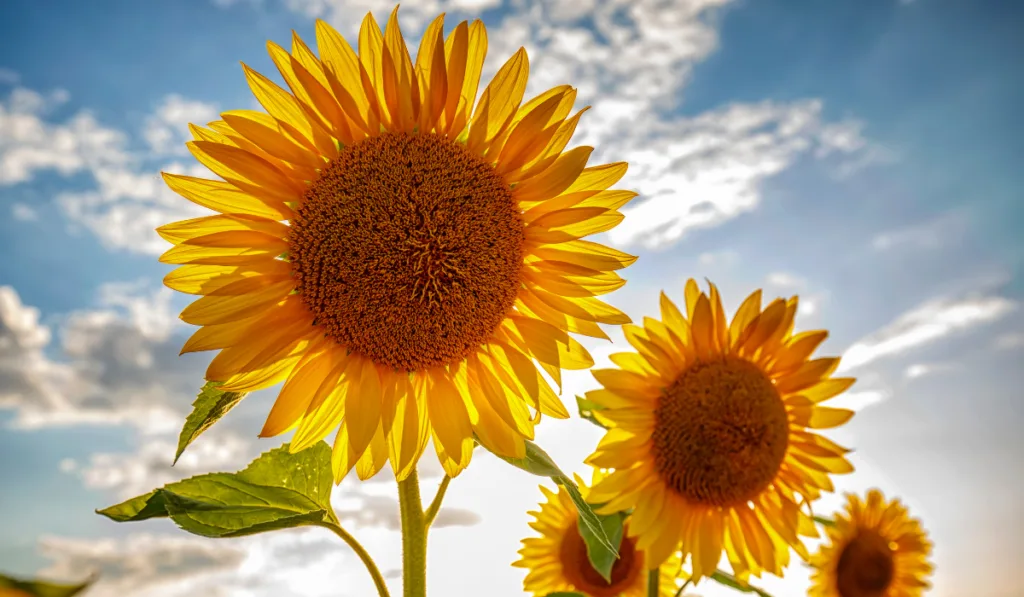
You probably already know about Sunflowers. They are one of the hardiest flowering plants around. Once they start growing, you only need to offer minimal care for them to survive. Sunflowers have large-sized daisy-like blooms with a brown center that contains a lot of seeds when ripe.
While sunflowers are primarily ornamental, their seeds are edible.
Sunflowers are best grown in well-drained soil while exposed to full sun. When growing sunflowers, do not fertilize them excessively. If you do, the steams may break during their peak blooming period.
Their ideal growing zones span from 3 to 10. Sunflowers symbolize loyalty, longevity, and admiration.
Resources
- https://orchidrepublic.com/blogs/news/types-yellow-flowers-meanings
- https://problog.ftdi.com/blog/yellow-flowers/
- https://www.floraqueen.com/blog/sending-yellow-flowers-means
- https://www.realflowers.co.uk/blog/the-meaning-of-yellow-flowers-and-when-to-send-them/
- https://florgeous.com/yellow-flowers/
- https://florgeous.com/primrose-flower-meaning
- https://www.venusetfleur.com/blogs/news/yellow-rose-meaning-history-of-the-yellow-rose
- https://florgeous.com/snapdragon-flower-meaning
